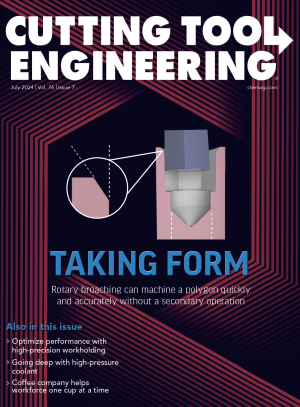Coolant has always been a component of successful machining processes. However, with more advanced machining techniques like deep-hole drilling and deep-pocket milling, it has become a critical element of the process.
When machining was characterized by big tools taking slow heavy cuts, coolant was applied primarily to absorb heat from the system. Keeping the tool and workpiece cool was the only concern. Shops were usually only concerned about maintaining the level in the tank so they didn’t starve the tool. In many cases concentration was monitored by the senses and maintenance was unscientific.
Coolant is far more critical in modern applications. Deep-pocket milling and deep-hole drilling are two good examples to illustrate this point.
What is deep-hole drilling? Generally, manufacturers define it is as drilling any hole that is eight times deeper than the diameter of the tool. So, drilling a 1" diameter hole that is 8" deep would be considered deep-hole drilling. The ratio of diameter to length is often referred to in shorthand as 8D, 10D, etc., and there is some variation in definition in the cutting tool market.
No matter the definition, when the drill gets deep into the part, the application of coolant is critical. Coolant has three primary functions in a deep-hole application. First, it absorbs heat energy released in the chip formation process. Second, it lubricates the tool chip interface as well as the flutes and the wall of the drilled hole. Finally, it is needed to assist the flutes in flushing the chips from the hole.

Lubricating the tool chip interface also aids chip formation. More importantly, it reduces heat from friction generated by the chip sliding across the tool while it also reduces built-up edge (BUE), which alters the geometry of the tool and can lead to a cycle of events that result in tool failure. As the BUE increases, the tool geometry is altered leading to more heat, which exacerbates the BUE process. The BUE will go through a cycle of buildup and break off, often taking small amounts of the tool edge with it. As the cycle continues it becomes exponentially worse until the cutting edge is no longer capable of forming a chip and the pressures exerted on the tool cause failure.
Cooling the tool and the workpiece enhances chip formation and encourages chip breakage. Every machinist knows broken chips are better than stringers and bird nests. However, broken chips are bad if they are not evacuated from the hole. Properly applied coolant flushes the broken chips from the hole preventing them from building up between the tool and the wall of the hole, which will ultimately lead to breakage.
Deep-pocket milling is another process where coolant is a critical part of success. Each machining process is different, and there is no common definition from one shop to the next. That said, deep-pocket milling has some common characteristics. The most common of which is depth of the work zone relative to the stick out length of the tool. Second, and the most significant, the work area is enclosed in a way that prevents chips from easily being evacuated from the cutting zone.
In deep-pocket milling, as in deep-hole drilling, coolants absorb heat, lubricate the tool and flush chips from the work zone. However, unlike drilling that must have liquid coolants, milling does not require the work zone to be flooded with a liquid coolant.
Deep-hole drilling is riskier than milling because the flutes are always in contact with the sides of the hole. In deep-pocket milling the tool is usually not fully engaged in the cut, and when it is fully engaged the cutting depth is very shallow. Therefore, it is not necessary to surround the tools with liquid coolants to prevent damage from the tool rubbing the wall and generating heat.
Still, removing chips from the pocket is just as important as removing them from a deep hole. Flood coolant is usually the method of choice because it is a standard feature on every machine. Blasting large volumes of coolant into the pocket at high velocity is the method most often used to keep the work zone clear of chips and eliminate the risk of re-cutting and tool damage.
Because milling is not subject to the same type of failures as drilling, other types of coolant application methods like minimum quantity lubrication (MQL) and mist cooling are available for use in deep-pocket milling.
Mist cooling, as the name implies, works by a applying a mist of coolant to the workpiece and the tool. The liquid is picked up from the storage tank by passing compressed air over an orifice that creates a vacuum drawing the liquid into the nozzle. As the compressed air leaves the nozzle it carries the liquid with it as a fine mist. The operator can control the amount of mist that is generated, but has little control over the coolant to air mixture.
MQL is similar to mist cooling, and to the layperson it probably appears the same. Unlike mist cooling, MQL provides precise control of the lubricant to air mixture. Where mist cooling draws the liquid into the air stream via venturi effect, MQL uses a pump to meter the lubricant into the airstream. The result is a near dry film that provides many of the same benefits as flood coolant.
Because mist and MQL cooling use high velocity shop air, they are excellent choices for blasting the chips away from the tool, but they are still a risky bet for deep holes. There are some tool manufacturers and MQL manufacturers working together to develop a deep-hole drilling process that is robust and reliable, but the safe bet is still high-pressure, through-spindle application of traditional water-based fluids.
Modern tools, CAM systems and machining techniques have made it possible for machine shops to eliminate coolants for many applications. Reducing and eliminating coolants and cutting fluids not only reduces costs it has a positive impact on the environment. Maybe we will see advancements in the future that eliminate the need for coolants in extreme applications like deep-hole drilling and deep-pocket milling.
Related Glossary Terms
- built-up edge ( BUE)
built-up edge ( BUE)
1. Permanently damaging a metal by heating to cause either incipient melting or intergranular oxidation. 2. In grinding, getting the workpiece hot enough to cause discoloration or to change the microstructure by tempering or hardening.
- built-up edge ( BUE)2
built-up edge ( BUE)
1. Permanently damaging a metal by heating to cause either incipient melting or intergranular oxidation. 2. In grinding, getting the workpiece hot enough to cause discoloration or to change the microstructure by tempering or hardening.
- computer-aided manufacturing ( CAM)
computer-aided manufacturing ( CAM)
Use of computers to control machining and manufacturing processes.
- coolant
coolant
Fluid that reduces temperature buildup at the tool/workpiece interface during machining. Normally takes the form of a liquid such as soluble or chemical mixtures (semisynthetic, synthetic) but can be pressurized air or other gas. Because of water’s ability to absorb great quantities of heat, it is widely used as a coolant and vehicle for various cutting compounds, with the water-to-compound ratio varying with the machining task. See cutting fluid; semisynthetic cutting fluid; soluble-oil cutting fluid; synthetic cutting fluid.
- flutes
flutes
Grooves and spaces in the body of a tool that permit chip removal from, and cutting-fluid application to, the point of cut.
- gang cutting ( milling)
gang cutting ( milling)
Machining with several cutters mounted on a single arbor, generally for simultaneous cutting.
- milling
milling
Machining operation in which metal or other material is removed by applying power to a rotating cutter. In vertical milling, the cutting tool is mounted vertically on the spindle. In horizontal milling, the cutting tool is mounted horizontally, either directly on the spindle or on an arbor. Horizontal milling is further broken down into conventional milling, where the cutter rotates opposite the direction of feed, or “up” into the workpiece; and climb milling, where the cutter rotates in the direction of feed, or “down” into the workpiece. Milling operations include plane or surface milling, endmilling, facemilling, angle milling, form milling and profiling.
- shop air
shop air
Pressurized air system that cools the workpiece and tool when machining dry. Also refers to central pneumatic system.








